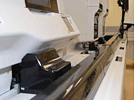Diagnostics
Lab system reduces turnaround time by 10%
May 4, 2016

KITCHENER, Ont. – Since the launch of its automated lab one year ago, Grand River Hospital has experienced a 10 percent reduction in test result turnaround times. Improved test turnaround times, in turn, have reduced treatment delays, wait times and patient length of stay.
The new lab system uses the latest technology to simplify processes, increase quality, reduce errors and improve test turnaround time for nearly 2.2 million patient tests a year.
“The automated lab uses state-of-the-art equipment and technology to ensure to a greater degree than ever before that the hospital’s lab performs the right test for the right patient and an accurate result in the fastest possible time,” says Dr. Dimitrios Divaris, chief of laboratory medicine and medical director of laboratories for Grand River and St. Mary’s Hospitals.
The now one year old fully automated specimen testing system is linked through a single integrated track. It uses high-tech equipment and software to carry specimens to various pieces of equipment that prepares, tests and retrieves samples for further testing. The system also sends results electronically to physicians.
This year, auto-verification was implemented to even further improve turn-around-times. The system has been validated to ensure that results not needing intervention by laboratory professionals are available immediately to the practitioner.
The automated lab system, manufactured by Ortho Clinical Diagnostics, Sysmex and Stago was installed at a cost of $3.2 million in 2015 and remains the first-of-its-kind in Canada.
A team of medical lab technologists, medical lab assistants and other support staff work within the automated lab to complete nearly 6,000 tests a day received from across the hospital. Lab automation will allow more tests to be done faster, without increasing staff as demand for healthcare grows in the coming years.
For Cherrie Martinez, a medical lab technologist at GRH, the automated lab has helped her focus more time on reviewing patient test results and on quality improvement.
“The automated system has certainly played a big role in optimizing lab performance by improving our workflow,” says Martinez. “It has made our job a lot easier and we can get more tests done faster.”
By some estimates, 85 percent of clinical decisions are based on lab test results. The automated lab ensures standardization, efficiency, timeliness, and quality among all of their functions that lead healthcare providers to make the best care decisions for patients.
“When time is of the essence, faster, more accurate lab results will help to ensure a better quality of care for our patients,” says Martinez.
